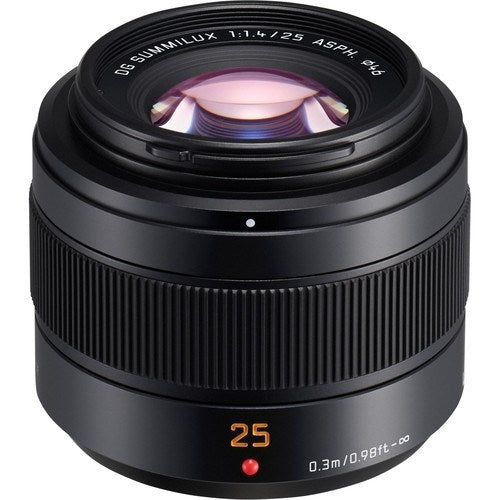Product Description
Panasonic Leica 25mm f1.4 II ASPH DG Summilux Lens: Precision Optics for Every Scene
The Panasonic Leica 25mm f1.4 II ASPH DG Summilux Lens is a premium prime lens designed for Micro Four Thirds cameras, offering a 50mm equivalent focal length on full-frame systems. Its wide f1.4 aperture makes it perfect for low-light conditions and creative depth of field control, while the rugged, splash and dust-resistant design ensures it can withstand harsh environments. Whether you’re shooting stills or video, this lens offers stunning performance with fast, smooth autofocus and exceptional image quality.
Key Features:
- 25mm Focal Length (50mm equivalent): Versatile for a wide range of photography, from portraits to landscapes
- Bright f1.4 Aperture: Perfect for low-light shooting and creating beautiful bokeh
- Splash and Dust-Resistant: Rugged design for outdoor and professional use
- 240 fps Sensor Drive: High-speed autofocus for fast, precise shooting
- Nano Surface Coating: Reduces ghosting and flare for sharp, clear images
- Compact and Lightweight: Portable without sacrificing build quality
- 9 Elements in 7 Groups: Includes 2 aspherical elements and 1 UHR lens for edge-to-edge sharpness
Wide f/1.4 Aperture for Low-Light Flexibility and Stunning Bokeh
The f1.4 maximum aperture is one of the standout features of this lens, providing exceptional low-light performance and allowing for precise control over depth of field. With its 50mm equivalent focal length, this lens is perfect for portraits, street photography, and everyday scenes. The wide aperture also produces beautiful, soft bokeh, making your subjects stand out against defocused backgrounds.
Fast, Silent Autofocus for Stills and Video
The Panasonic Leica 25mm f1.4 II integrates a stepping motor and inner focus drive system that work together to provide fast, smooth, and silent autofocus. This makes it an ideal lens for videographers as well as photographers. Paired with Panasonic Lumix G series cameras, the lens excels in high-speed and precise contrast autofocus, ensuring your subject stays sharp whether you’re shooting still images or video.
Compact, Sturdy Construction
Built with both portability and durability in mind, this lens features a compact and lightweight design while maintaining high-quality construction. Its optical system is composed of 9 elements in 7 groups, including 2 aspherical elements and 1 Ultra High Refractive (UHR) index lens, delivering high-resolution, distortion-free images across the entire frame.
Nano Surface Coating for Crystal-Clear Images
Panasonic’s Nano Surface Coating ensures that ghosting and flare are minimized, even when shooting in challenging lighting conditions or directly towards bright light sources. This advanced coating allows for sharp, high-contrast images, so you can maintain creative flexibility without worrying about unwanted reflections or loss of clarity.
What's in the Box:
- Lens cap
- Rear lens cap
- Lens hood
- Lens storage bag
For full specifications click Here
Payment & Security
Your payment information is processed securely. We do not store credit card details nor have access to your credit card information.




















